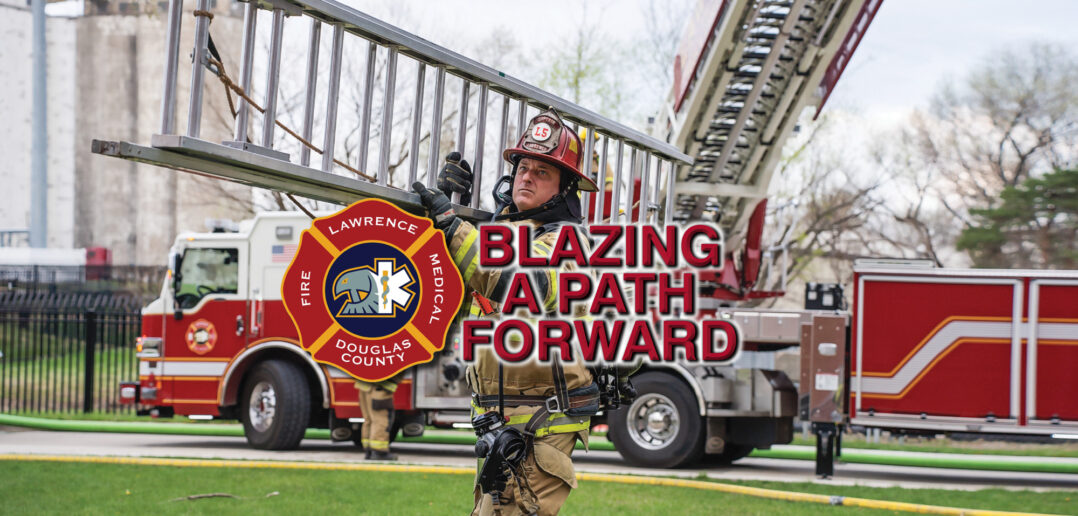| story by | |
| photos by | Steven Hertzog |
| OPEN A PDF OF THE ARTICLE |
Lawrence-Douglas County Fire Medical continues a progressive track as it leans on the past to launch itself into the future.
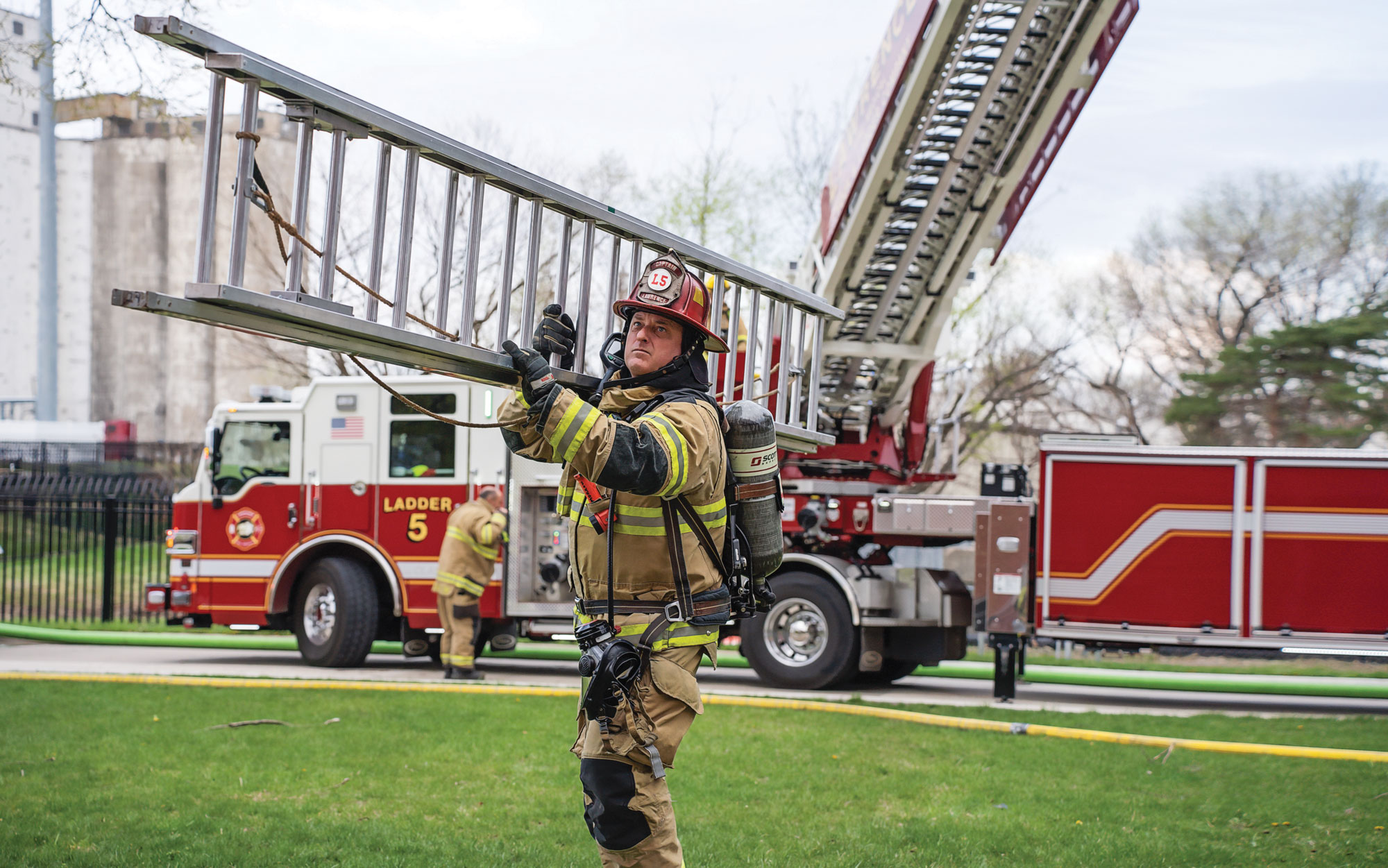
Fire Medical Training conducted by LFD photos by Taylor Mah
First formed in 1859 as a volunteer fire department, disbanded in 1862 because of the Civil War and officially incorporated as a 10-member, full-time agency in 1915, Lawrence-Douglas County Fire Medical is a department full of history.
Walking into the administration offices attached to Station No. 5, at 1911 Stewart Ave., one is greeted by an array of displays documenting that historical legacy, curated by unofficial department historian Dylan Brown. The displays show the department where it’s been and help it determine where it’s going, says Lawrence-Douglas County Fire Medical Fire Chief Rich Llewellyn.
“There wasn’t actually a fire department here when Quantrill’s Raid occurred,” Llewellyn says. “I like to think that we pioneered women in the fire service, because it was women who were putting out the fires that were left after Quantrill disappeared from here.”
It’s nice to have that touchstone to the past, he continues, to be able to look and see where they’ve come along.
“We’ve been progressive,” the fire chief explains. “Early in our history, we had one of the first motorized ladders trucks that was anywhere in the Midwest, and folks came around from all over to see it. As we move in the future, it’s nice to recognize that we have been progressive in the past, and we can continue with being a progressive agency.”
Any agency can encounter challenges going forward. When it comes to recruitment and retention, one might think a college town would provide a regular group of new graduates; but the constant burn and churn of the city’s population offers its own issues.
“Speaking to that specific thing, we haven’t seen a ton of relation with KU graduates,” says McKenzi Ezell, the Fire Medical data analyst and accreditation manager. “That is something that we’ve talked about—trying to get more into that realm and being more visible and making those connections.”
“We’re finding—and I don’t think Lawrence is isolated in this, it’s a phenomenon that’s occurring across the country—that fewer folks are interested in getting into the fire service,” Llewellyn adds. “We’re not seeing hundreds of people apply for positions. We’re seeing dozens of people apply for positions.”
Lawrence-Douglas County Fire Medical has to be more intentional in its recruiting, he continues. This includes reaching out to the University of Kansas (KU) and showing up at career fair events, as well as reaching out to Haskell University to try to leverage the relationship with those recruiting pools.
“Those are folks we want,” Llewellyn emphasizes. “We want people who have been here in Lawrence and want to continue to remain in the area and serve the city.”
Ezell agrees. The department is unique in that it does emergency medical services countywide and fire-suppression services in the city and Grant Township.
“I think that gives us a unique … perspective that it’s not just a fire department, but it’s truly a fire-medical service,” she continues. “We’ve really honed in on the medical side, especially with our transport and transfer medic units.”
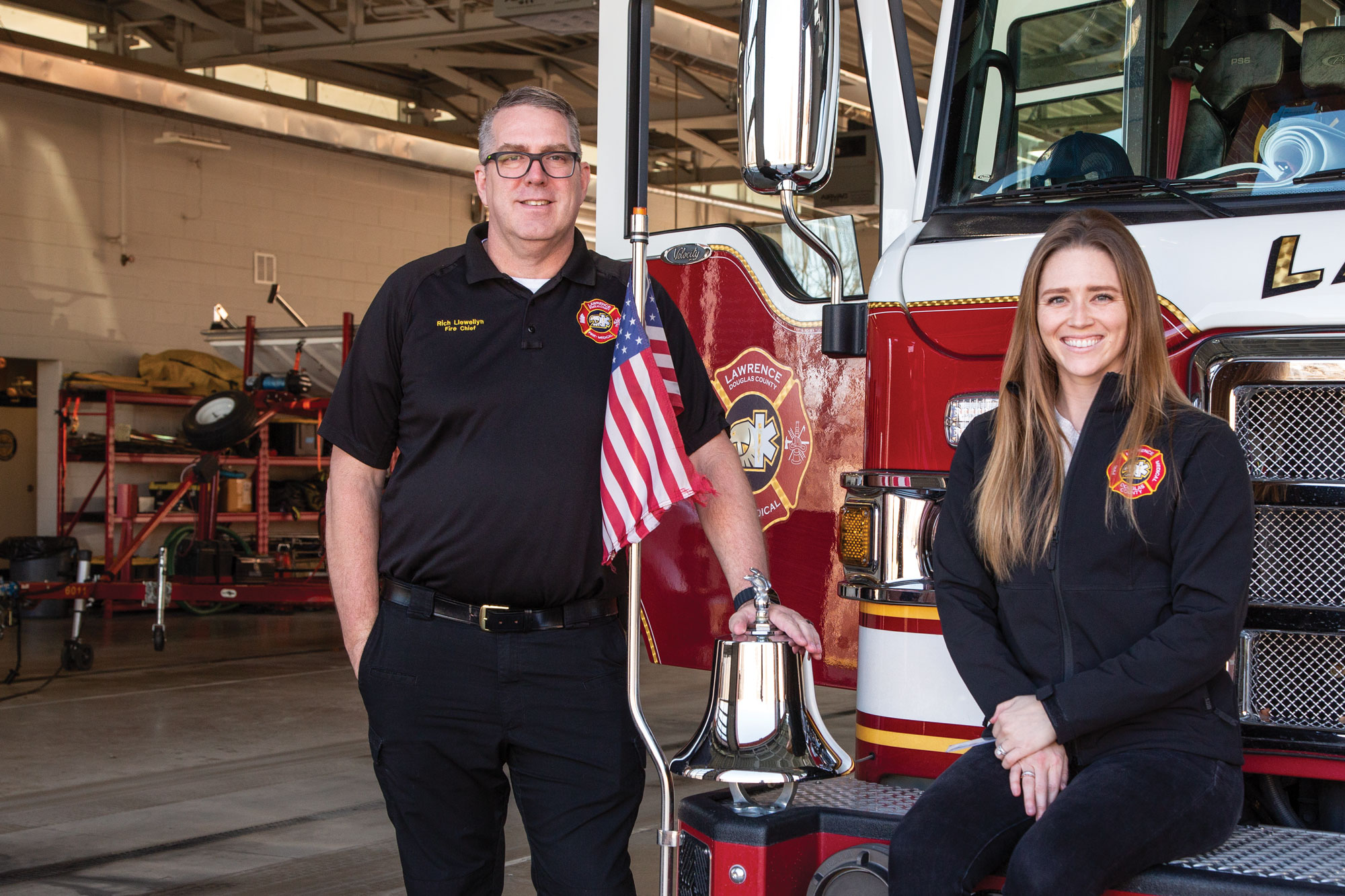
Lawrence Fire Chief Richard Llewellyn and McKennzi Ezell, CPM-Fire Medical Data Analyst
Planning Ahead
All of Lawrence-Douglas County Fire Medical’s firefighters have some level of emergency medical technician experience or certification, either EMT (emergency medical technician) basic or advanced EMT or paramedic. It’s pretty common across the country, with most firefighters these days having some type of medical training to respond to EMS incidents, whether just doing first response or, if they work for an agency such as Lawrence-Douglas County Fire Medical, also doing transports.
Fire suppression within the boundaries of the city and Grant Township along with EMS coverage of the whole county presents certain logistical issues. One such issue is timing to get from one place to another, whether it’s a one-day event like a parade or football game, or something more lengthy, such as the current work being done on Sixth Street. Getting the department into different parts of the city and county requires quite a bit of early planning.
LOCAL MATTERS
Our Local Advertisers – Making a Positive Impact
“It’s a big county, and we have to take access into account,” Llewellyn explains. “If there’s an event that’s plugging up the bridge over the Kansas River, we have to consider that. When we get that advance notice, we take a look at those events, and we may station an apparatus in North Lawrence, for example, temporarily during the St. Pat’s parade.”
When there is the Maple Leaf Festival in Baldwin City, Lawrence-Douglas County Fire Medical can anticipate it’s going to have extra work in Baldwin City and plan how to access those patients. Staff works very closely with partners and other agencies, such as the Baldwin City Fire Department in this example.
“We have to know where they’re going to have patients, how we can access them, are they going to bring them to us, do we need to go to them?” Llewellyn says. “Those conversations happen in advance. It’s just a recognition of the complexity that we face.”
When determining who goes where, Ezell says all units in Douglas County are dispatched through the Douglas County Emergency Communications Center, which is based on AVL (automatic vehicle locator).
“If a call is in a certain part of the area, say the southwest part of Douglas County, it’ll dispatch the closest unit,” she explains, adding that Lawrence-Douglas County Fire Medical has two stations out in the county with medic units: Station No. 12, which is in the city of Eudora, and Baldwin City’s Station No. 11. “Those units don’t just stay in their little area. They can go wherever.”
Blurred Lines
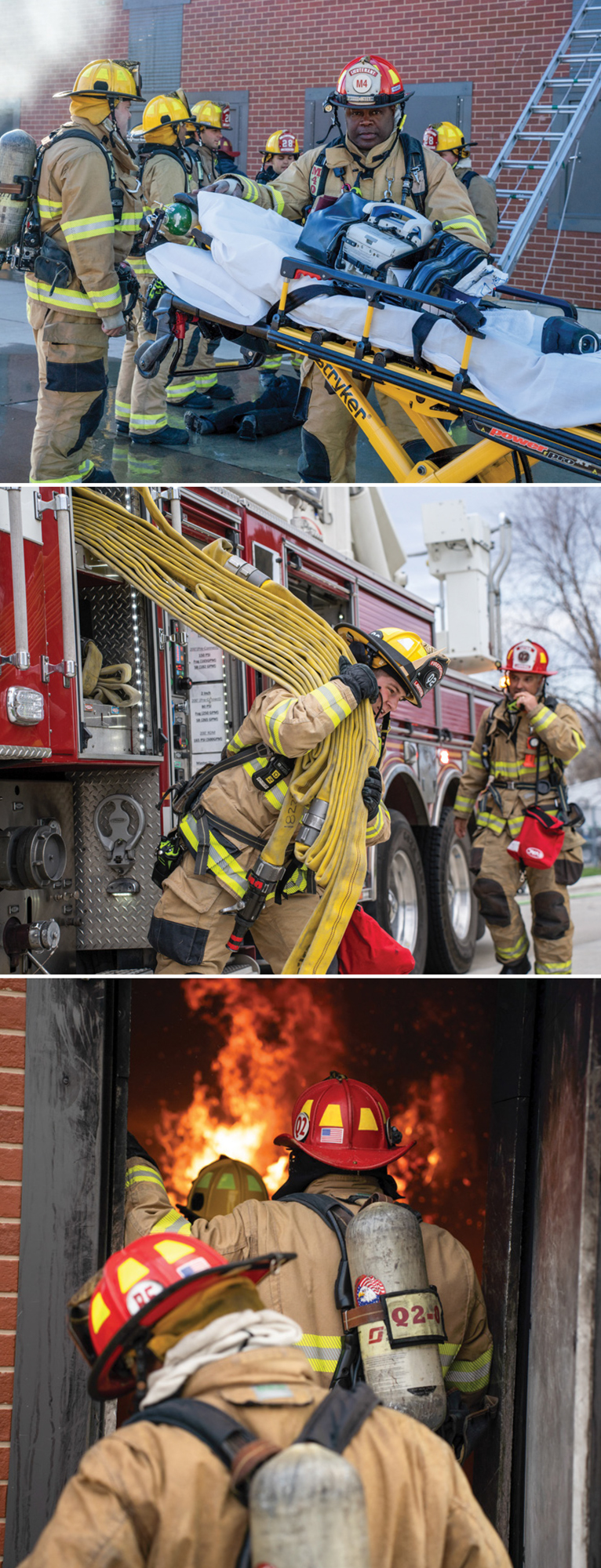
Live burn Training conducted by LFD and other training photos by Taylor Mah
Being able to go wherever becomes important when medical responses are needed where city limits and county lines merge. The Panasonic plant in DeSoto, an industrial facility that will construct batteries, could pose a problem with chemicals on an industrial scale. Many fire departments in Douglas County are closer to that factory than those in Johnson County.
Complex incidents tend to blur jurisdictional lines because of the potential for significant resource needs, Llewellyn explains, and so building a factory becomes a spiderweb of issues with which Lawrence-Douglas County Fire Medical might have to deal.
“One little twinge on a part of the web is going to impact the rest of the system,” he adds. “If we do have something that’s going here in Lawrence, and we’re bringing in partners from other entities to assist us, it’s creating issues with those other entities as far as them needing more resources.”
Llewellyn has been fire chief since 2022, having previously been assistant chief of administration for the Everett Fire Department, in Western Washington. He says when he first got here, one of the challenges in the organization’s worldview was that it was very focused on what’s happening here in Lawrence and in Douglas County. He has been trying to expand that to incorporate other entities, identify mutual aid partners and sign agreements with them.
“We are working very diligently on finding partners who we can both help and who can help us,” the fire chief says, pointing to other fire and EMS agencies as those that have usable resources or might need resources that Lawrence-Douglas County Fire Medical can provide.
Ezell highlights the work the department does with city and county agencies, saying there are many people in the department who go to planning meetings for new builds, such as the Panasonic plant, along with those who specifically work with KU or KU Athletic events, as well as Douglas County Emergency Management hosting workshops to start planning for some big events that could happen.
“I think that those workshops really facilitate the time and the coordination for all of these agencies to come together to start brainstorming some of these things and to see how that web can be impacted,” she emphasizes, explaining that all of these interagency meetings have attendees discussing resources not only in Douglas County but outside of Douglas County, as well.
“We’ve experienced a profound amount of change in the last five years in this industry, and so we do have to stay on top of new technology, new techniques,” Llewellyn says, pointing to COVID, which created conditions the department had to address, including changing orders and procedures on a weekly and sometimes daily basis. “We do like to look out and see what’s available and makes sense for us to bring in.”
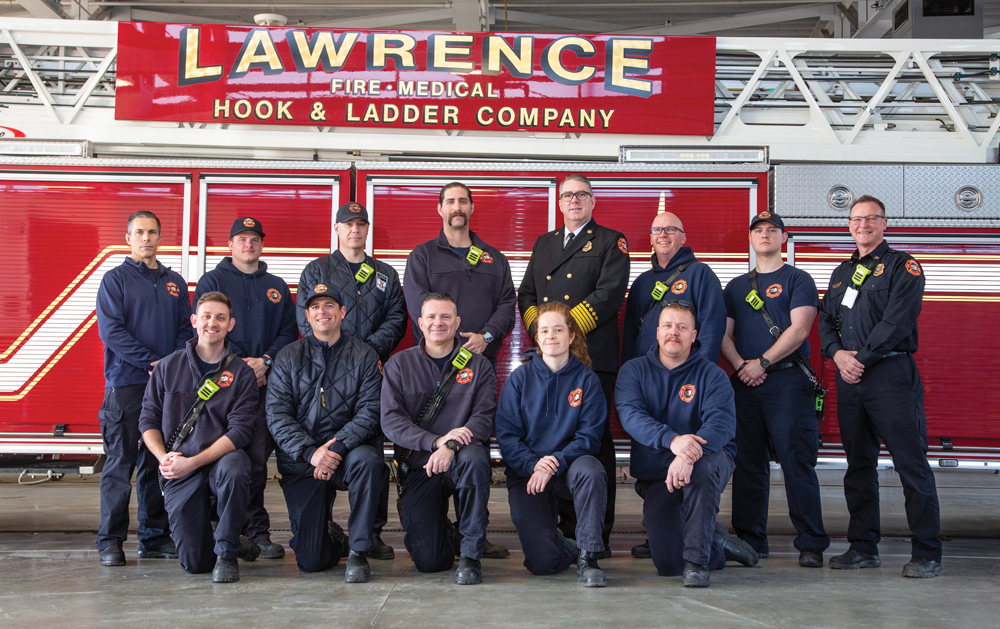
Front row l-r: Jacob Cruse, Michael Mathews, Aaron Davenport , Zoe Mays, Trey Strohm; Back row l-r: John Dines, Adam Eudaly, James Barkley , Jack Dolan, Rich Llewellyn , Brian Trigg , Patrick Schneider, Justin Temple
Looking to the Future
One recent program Lawrence-Douglas County Fire Medical implemented is called PulsePoint, a crowdsourced app that allows people with EMS training or medical training and the ability to do CPR to respond to CPR events in public places.
“If you’re sitting here, and there’s somebody (who) needs CPR across the street, and you have PulsePoint, you’re gonna get a notification,” Llewellyn explains. Additionally, the PulsePoint app provides public notifications about what your fire department is doing. “So if you hear a siren going by, you can pull up PulsePoint, and you can see, ‘Oh, they’re going to a medical incident on Sixth Street.’ Those technologies are allowing us to not only respond better, allowing the community to be involved, but also getting our message out there.”
No more asking “What does Lawrence-Douglas County Fire Medical do?” “What are they going?” “Where are my tax dollars going?” With PulsePoint, you can see it in action.
“We are accredited, and accreditation really focuses on continuous improvement for fire service and fire medical service,” Ezell adds. “That process not only allows us to take a deep dive to look at ourselves and be reflective, but then also to look at other agencies regionally throughout the United States and then also internationally, to see what’s working where and for different communities.”
It’s been really beneficial to have people be a part of that process, she continues, because Lawrence-Douglas County Fire Medical has a lot of in-house trainers who go out and participate in as well as conduct training, and are able to bring it back to Lawrence and Douglas County, and implement what they’ve learned.
“It might not necessarily be tied to technology, but more of an advancement or awareness of technology that’s coming up,” Ezell adds, while also pointing out that coming soon is something that goes back to the technology previously discussed: the fire truck.
“Hybrid fire trucks are on our capital improvement plan,” she explains. “We have projects related to the replacement program of our fire trucks going from a diesel engine to a hybrid engine that has the ability to run off the electric side and then, in default, if it needs to go to the diesel engine, (it’s) able to do so.”
One thing the city’s also focusing on is standardizing citywide. Lawrence-Douglas County Fire Medical is working in coordination with the city to figure out what infrastructure will be needed to support these electric or hybrid fire engines and planning for future stations.
“The next five to 10 years … we’re focused on delivering a high-quality service,” Llewellyn says of future plans. “We want to make sure we’re able to respond to fires in a timely manner. We want to make sure that people live long and healthy lives, and that’s both our fire side and our EMS side. One of the major initiatives that we’re looking at for the future is our station locations.”
He explains that the department is behind in getting new fire stations, with one fire station that’s road-mapped to open in 2027-28 and sites currently being discussed to build it.
“We need some more stations around town, and we do have some aging infrastructure,” says Llewellyn, looking ahead. “We’re looking at building new facilities and replacing some older facilities. That’s going to be big for us in the next 10 years.”

